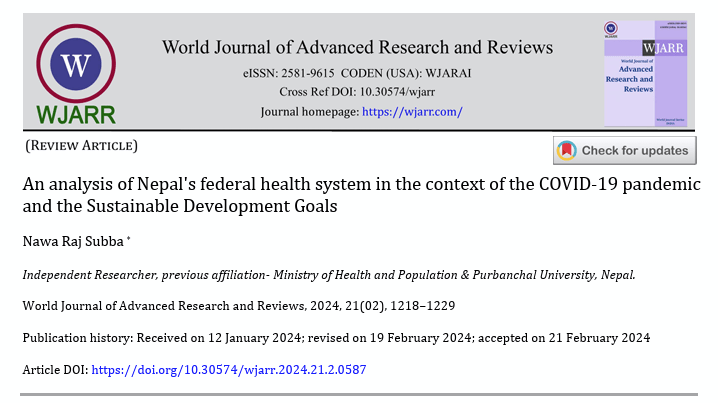‘समृद्ध नेपाल र सुखी नेपाली’नारा बोकेको दिगो विकास लक्ष्य पूरा गर्ने जिम्मेवारी आज तीन तहका सरकारले काँधमा बोकेका छन्। जनतालाई प्रत्यक्ष सेवा प्रदान गर्ने अभिभारा स्थानीय सरकारको भागमा परेको छ। स्थाइ सरकार मानिने करम्चारीतन्त्रको अवस्था स्थानीय तहमा कस्तो छ? प्रशासकीय अधिकृतको नेतृत्वमा लेखा अधिकृत, सूचना अधिकृत र स्वास्थ्य संस्था प्रमुखको समितिले स्वास्थ्यसम्बन्धी दिगो विकास लक्ष्य पूरा गर्ने जिम्मेवारी वर्तमान व्यवस्थाले दिएको छ।
यसबारे विभिन्न अध्ययन अनुसन्धान, छलफल, अन्तर्वार्ता र अवलोकनका आधारमा गरिएको यस अध्ययनले खासगरी स्थानीय तहका सरकारले प्रदान गर्ने स्वास्थ्य सेवा प्रवाहबारे लेखाजोखा गरेको छ।
सिद्धान्ततः चुनिएका जनप्रतिनिधिले नीति र योजना बनाउँछन्। त्यसलाई कार्यान्वयन गर्ने काम कर्मचारीतन्त्रको हो। त्यसका लागि सक्षम कर्मचारीतन्त्र हुनुपर्दछ। स्थानीय सरकारलाई दिगो विकास लक्ष्यका स्वास्थ्यसम्बन्धी सूचकांकलाई बलपुग्ने योजना बनाउन, कार्यान्वयन गर्न र तिनको मूल्यांकन गर्न जनस्वास्थय विषयको ज्ञान चाहिन्छ। सरकारले स्वास्थ्य ऐन नियमावली बनाएर स्वास्थ्यकर्मीलाई पदोन्नति गरेर पदस्थापना गरेको छ तर पदअनुसारको पढाई र तालिम दिएको छैन। यस्तो अवस्थामा दिगो विकास लक्ष्य हासिल गर्न तथा गुणस्तरीय सेवा प्रदान गर्न चुनौति देखिएको छ।
सही पदमा सही मानिसको व्यवस्था गरी सरकारले जनताको स्वास्थ्यमा संवेदनशील संवेदनशील र जिम्मेवार बन्नुपर्दछ।
Abstract
This paper is a review article on Health System of federal Nepal implementing Federalism. Nepal’s public health slogan was ‘Health for All’ with integrated community health services in 1991. The country created female community health volunteer network. District Public health offices (DPHO) managed these programs in their districts. After 2008 federalism, 2017 brought federal, provincial, and local governments. The federal health system substituted the administrative District Public / Health Offices in districts.
Now, the local governments or health institutions oversee the Sustainable Development Goals (SDGs). The federal and provincial authorities should have employed qualified professionals to oversee public health at local health facilities. Healthcare efficacy and goal attainment are concerns today.
This study did a microscopic investigation using health system studies. The researcher conducted field observations and stakeholder interviews and participated in public discussions. Researcher compared data from Nepal’s federal health system’s community status in SWOT analysis.
Identify Research Gaps
The study delved into specific research gaps thoroughly. According to previous research, health infrastructure could be more effective with financial expenditures.
The researcher emphasizes the need for good governance and suggests allocating 6% of national GDP to health spending. There is a need of trained public health staffs.
Nepal changed its health system in 1991 by creating Village Health Committees (VHCs) and District Health Offices (DHOs) to give primary healthcare to people in their communities. The Ministry of Health Nepal wanted to make healthcare services accessible and fair for everyone [1]. The changes had some excellent effects, like fewer mothers dying [2] and more children getting vaccines [3]. However, some problems still existed, like the difference between rural and urban areas and the lack of resources that needed more attention [4].
According to the Constitution of Nepal [5], federally Nepal formed local and provincial governments. Local governments took over the responsibilities of health facilities like health posts, primary health care centres and district hospitals. The new District Health Offices (DHOs) lack the necessary power and resources to be as effective as the previous District/Public Health Offices [6]. Some people are concerned that DHOs must pay more attention to local health services, which could make health services efficient [7].
Health System of Federal Nepal
Health workers now work for the local government and answer to them not DHOs. Therefore, more research is needed to see how well this decentralization process works and how it affects public health in Nepal.
Concerns arise over inefficient healthcare facilities. The government appoints health workers to important positions without formal education or professional experience. The tendency started following enacting the Health Services Act 1997 [8]. Additional training is necessary to enhance the quality of service and improve patient outcomes, as research studies indicate [9].
Local health institutions with ineffective human resources may hinder the attainment of specific Sustainable Development Goals, such as SDG 3 on Health and Well-being, as it requires competent nurses for healthcare provision and qualified public health officers for planning and administration [10]. Possible solutions include doing training programs to make sure people have the right man in the right place.
Conceptual Framework


